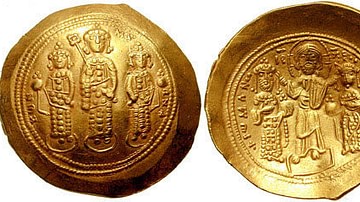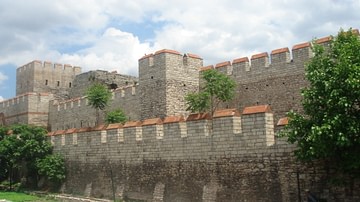
Greek Fire was an incendiary weapon first used in Byzantine warfare in 678 CE. The napalm of ancient warfare, the highly flammable liquid was made of secret ingredients and used both in catapulted incendiary bombs and sprayed under pressure so as to launch flames at enemy ships and fortifications. It was also used with success in defensive situations. Greek Fire became the most devastating weapon of Christendom for over seven centuries and ensured that Constantinople resisted all comers. Emperor Romanos II (r. 959-963 CE) knew its value and declared three things must absolutely never reach foreign hands: the Byzantine imperial regalia, any royal princess, and Greek Fire. As it turned out, the first two were, on occasion, bestowed on foreign rulers but never the third.
A Secret Formula
The invention of Greek Fire is credited to a Christian Greek named Kallinikos (aka Callinicus) who escaped to Constantinople from Muslim-held Syria in 668 CE. Flammable liquids had been used in both Greek and Roman warfare but nothing had ever been devised that was quite as lethal as Greek Fire. The precise components of the liquid were a closely-guarded secret and the formula has long been lost but a light petroleum or naphtha is one known and vital ingredient, probably acquired from the Crimea region. Other ingredients were quicklime, sulphur, resin and potassium nitrate. Some scholars suggest gunpowder was included in the mix. The process of making the liquid was a highly dangerous one, given its volatility. Distilling the petroleum element also required complex technology for the period. Known to only a select few, the recipe for Greek Fire was a jealously guarded state secret which emperors passed on to their successors. Thanks to these precautions the secret formula was kept in Byzantine hands alone for over seven centuries.
Use in Battle
Greek fire was first used in naval engagements where streams of the flaming liquid were fired under pressure towards enemy ships. The ships which usually carried Greek Fire were of the dromon type, a fast-sailing vessel which could also be propelled using oars. The exact design of the firing device is not known except that it was made from bronze tubes and included a syphon pump and swivelling nozzle. The apparatus must have been complex because an example and the necessary liquid fuel were once captured by a Bulgar force but they could not manage to actually use it. A 12th century CE illuminated manuscript, the Madrid Skylitzes, contains an illustration of one of Michael II's (r. 820-829 CE) ships shooting Greek Fire from a long tube towards a ship of Thomas the Slav during the latter's siege of Constantinople in 821-822 CE. In 2006 CE a full-size replica was constructed by John Haldon using reconstructed parts and Crimean oil. The endeavour was a success, firing intense flames 10 to 15 metres distant which were capable of incinerating anything in their path in seconds.
The dramatic effect of Greek Fire and the method of spraying it, according to the 6th century CE Byzantine historian Theophanes, “caused enemies to shiver in terror” (Bagnall, 2984). Just about anything on board an enemy vessel that came into contact with the liquid was immediately set ablaze - rigging, sails, men and even the ship's hull. Worse, there was no way of putting out the fire as water had no effect on it. A peculiar quality which made the weapon even more shocking was that it burned especially well on water. There was very little defence against it either - covering the ship in soaked hides, maintaining a safe distance or attacking during storms were all attempted without much success.
The Greeks began to fling their fire all around; and the Rusii seeing the flames threw themselves in haste from their ships, preferring to be drowned in the water rather than burned alive in the fire.
(Liutprand of Cremona, Antapodosis, describing a Byzantine battle in 941 CE)
Vital Victories
The almost magical weapon was sorely needed in the latter half of the 7th century CE. The Arab World was biting great chunks out of the Christian Mediterranean and their fleet seemed invincible. They conquered Sicily, Tarsus, great swathes of North Africa and even the mighty fortress of Rhodes. They then set their sights on the very heart of the Byzantine empire: Constantinople itself. The Arab ships formed three fleets, audaciously captured an island opposite the capital and then settled down to besiege the city for four long years. The Byzantines needed a miracle from the God who seemed to have forsaken them. In Greek Fire they certainly found one. Sailing out to meet the Arab fleet with their ships spouting flames, the enemy was routed. The trick was repeated against another Arab fleet only a few decades later in 718 CE, this time after suffering a one-year blockade.
It is impossible to exaggerate the importance of Greek Fire in Byzantine history. (J. J. Norwich, 176)
Time and again Greek Fire was used to devastating effect in naval warfare, notably by Romanos I (r. 919-944 CE) in 941 CE and Constantine IX (r. 1042-1055 CE) a century later, both against attacking Russian fleets. John I Tzimisces (r. 969-976 CE) used Greek Fire to good effect on land in 972 CE when he bashed his way into Preslav, the Bulgar capital which the Russians had captured, and so was able to liberate the Bulgar king. In 988-9 CE Basil II (r. 976-1025 CE) devastatingly combined Greek Fire with his magnificent force of Vikings, the Varangian Guard, to utterly quash the rebellion of the usurper Bardas Phokas. The military successes of the Byzantine empire and particularly the conviction that Constantinople was “God's protected city” were, then, in no small part due to Kallinikos' lethal invention.
Adaptations & Decline
Over time the full potential for Greek Fire was realised by adapting its use for land warfare. Portable pumps were devised so that flames could be fired either at or from fortifications. Another innovation was to fill clay grenades with the liquid or soak bales of cloth and catapult them into the enemy ranks. Its most devastating use remained, though, in naval warfare, where it was also used in unmanned fire ships sent with prevailing winds into the very heart of an enemy fleet - a tactic confirmed in the 1204 CE siege of Constantinople. For unknown reasons the use of Greek Fire is unrecorded from the Fourth Crusade (1202-1204 CE) onwards but for many centuries it had been the most important weapon in world warfare and crucial in the defence of the Byzantine empire.






